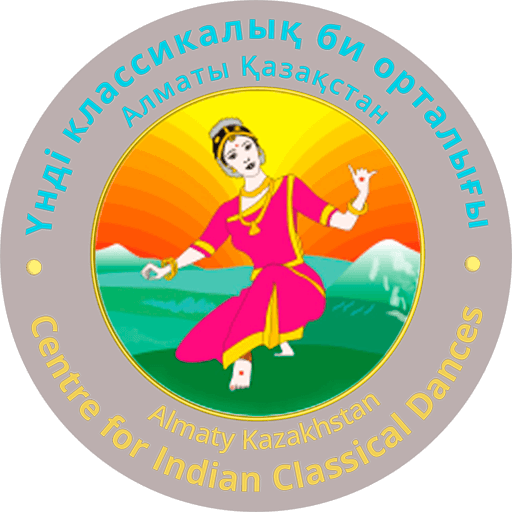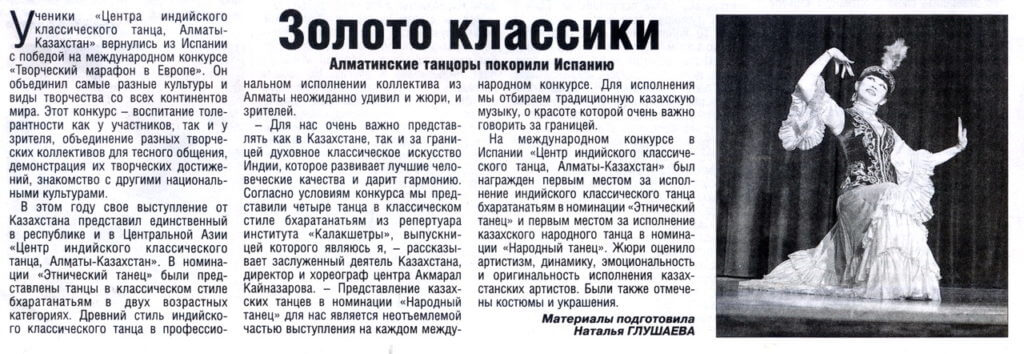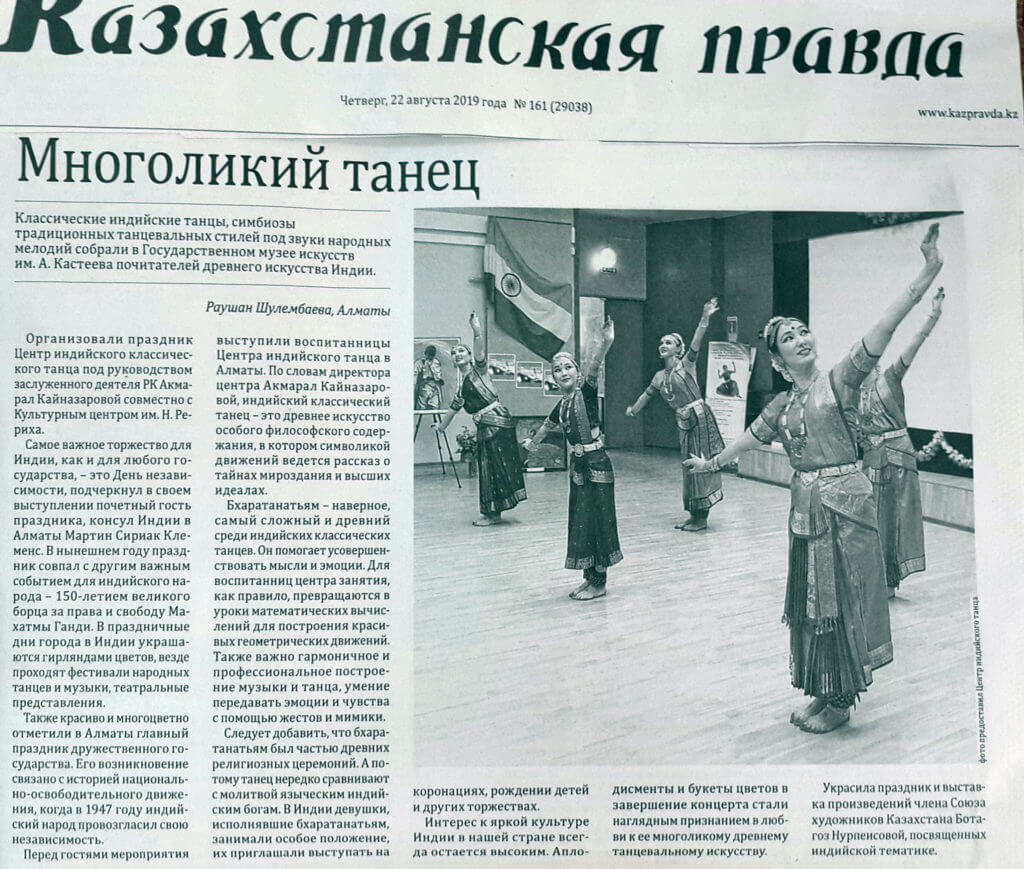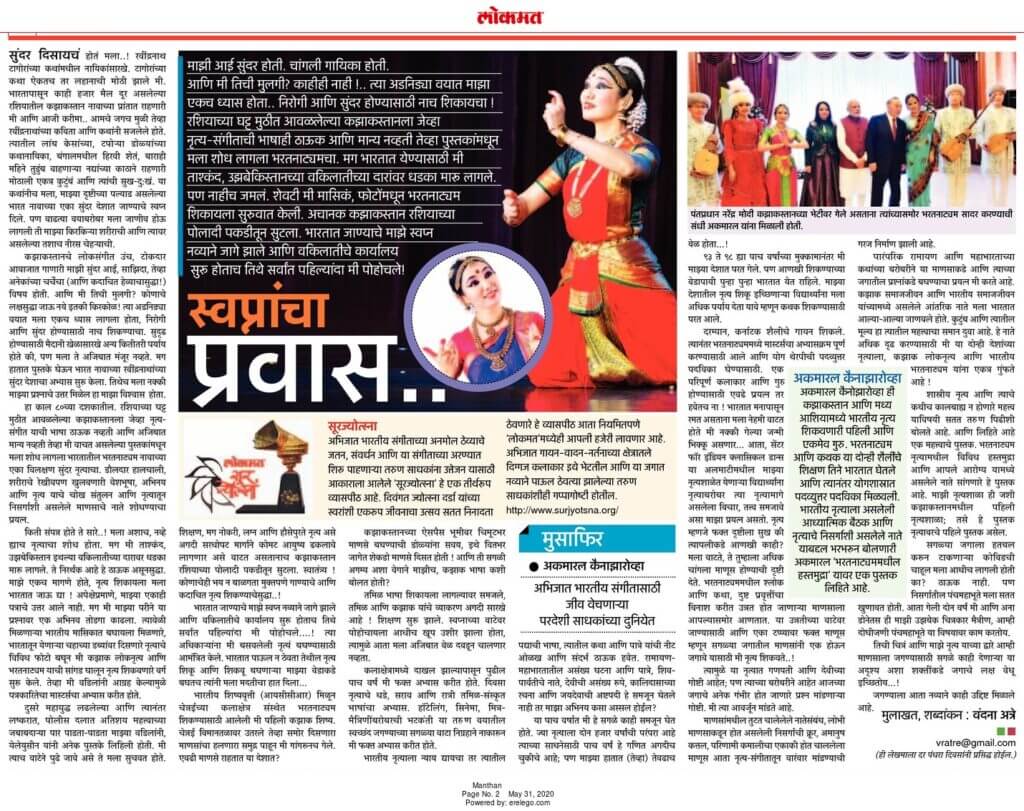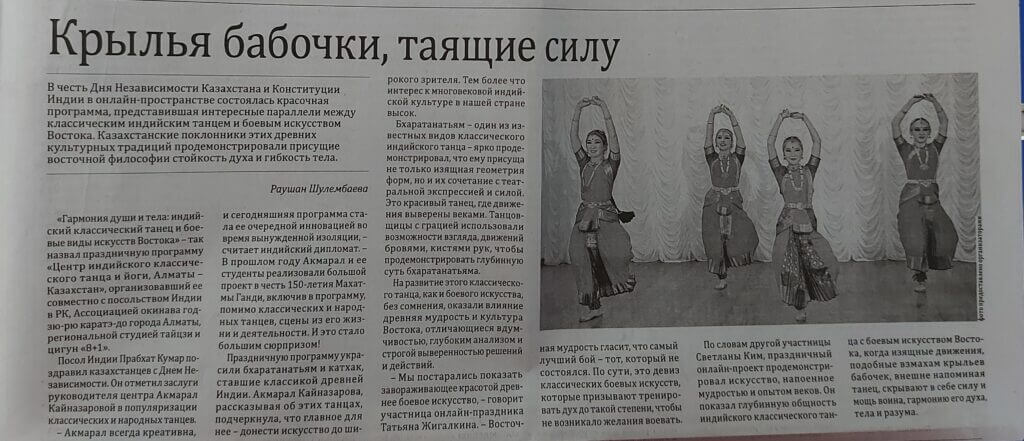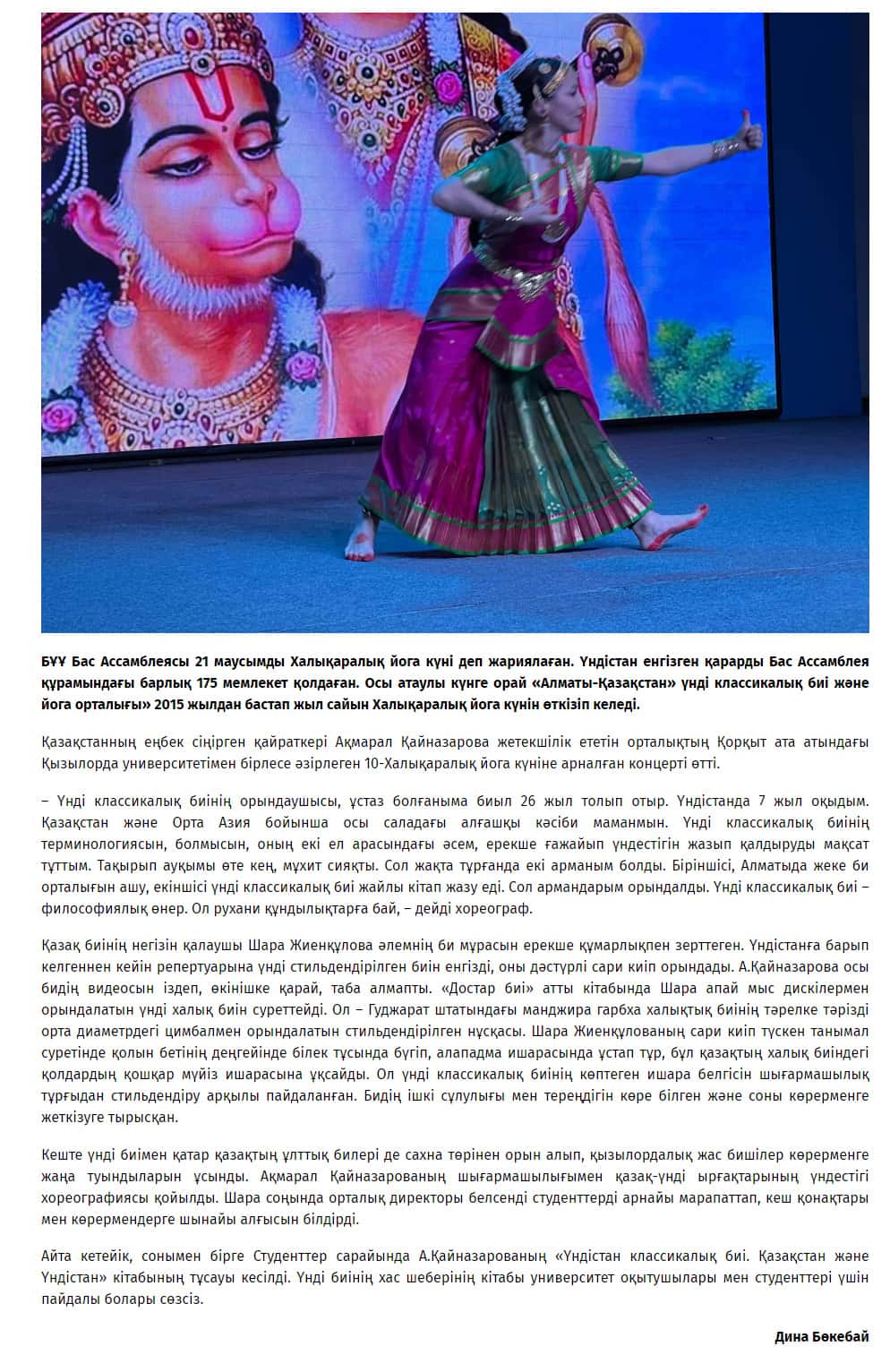
Kizilorda regional newspaper “Сыр бойы»
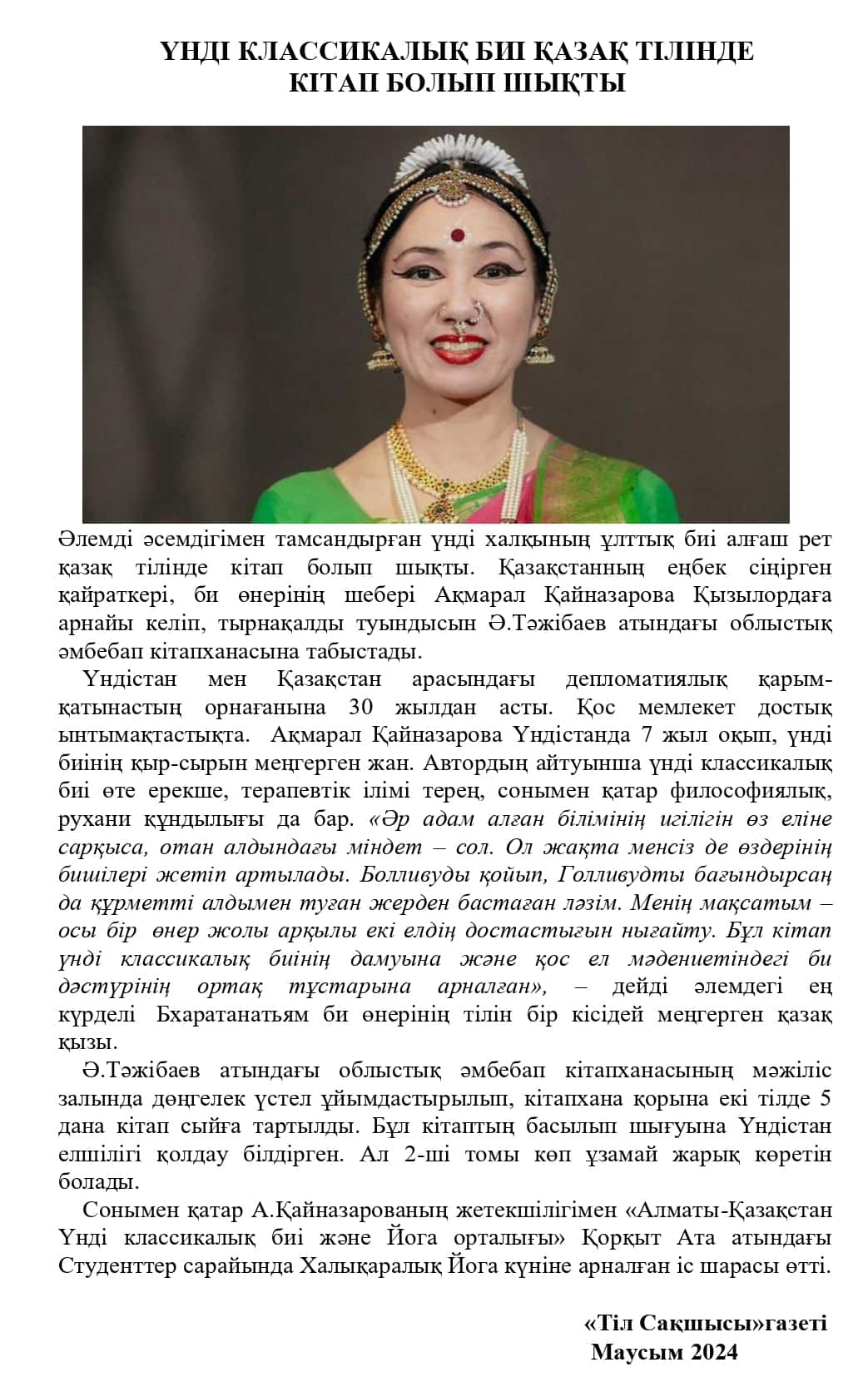
К 125-летию со дня рождения Мухтара Ауэзова, статья Акмарал Кайназаровой «Essays on India» by Mukhtar Auezov which is the first literary work on India in Kazakh literature». В журнале ICCR на языке хинди “Gagananchal” (Vol 46 issue 4 (July-August) 2023, c 41-46).
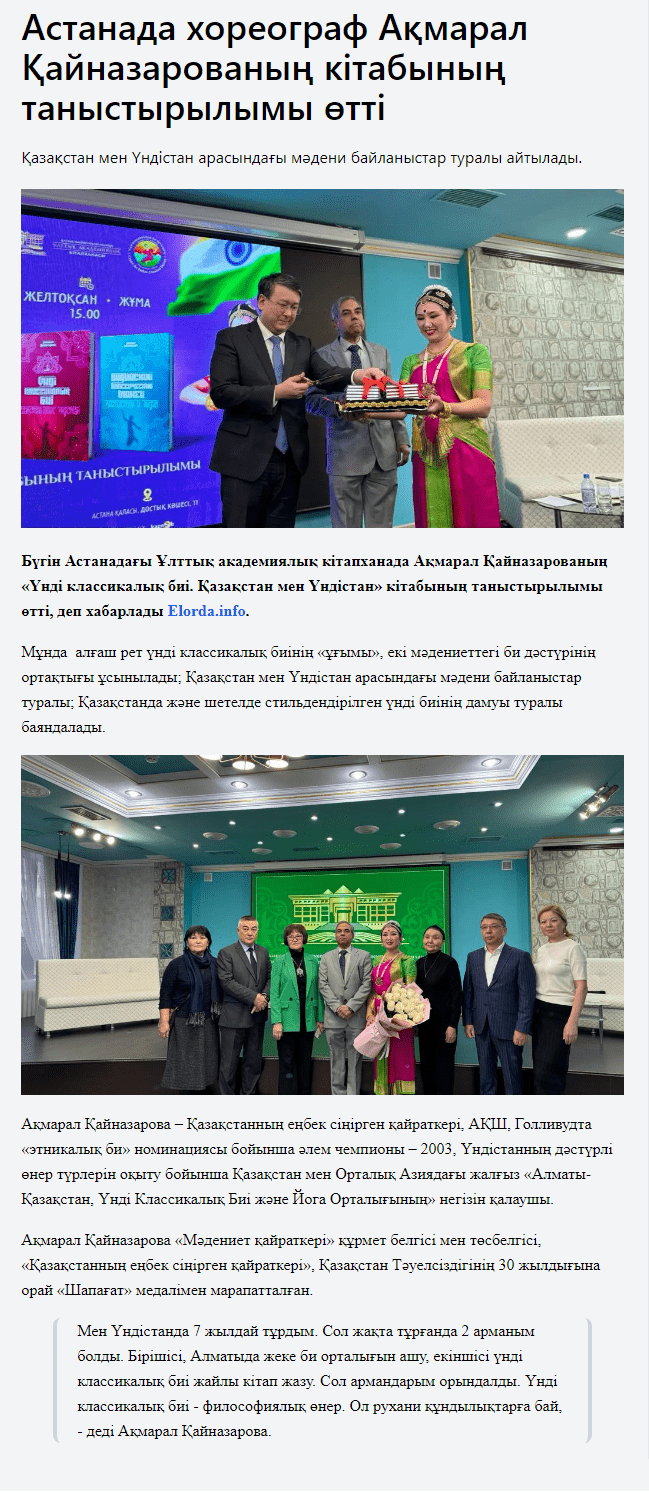
elorda.info
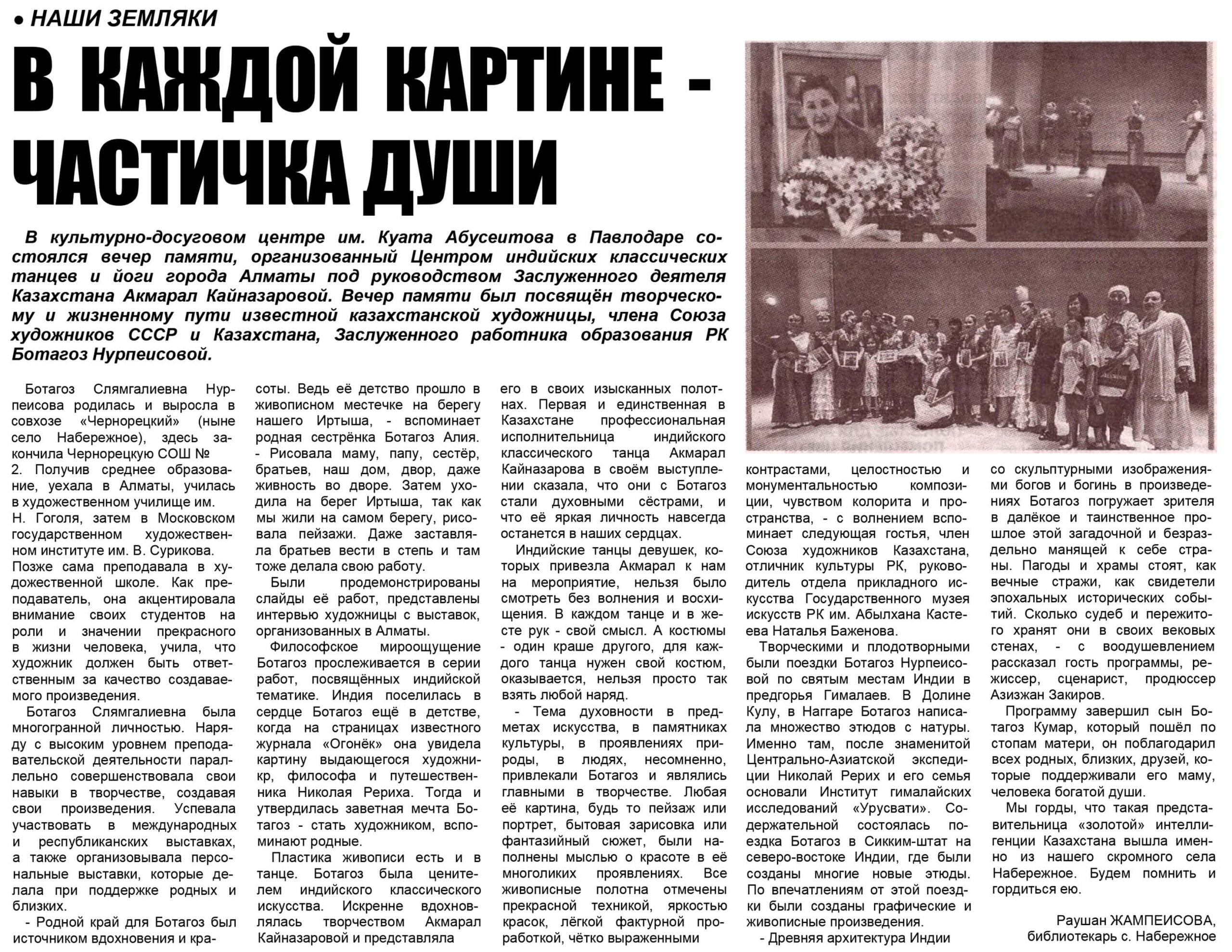
Нива

Uigur Avazi
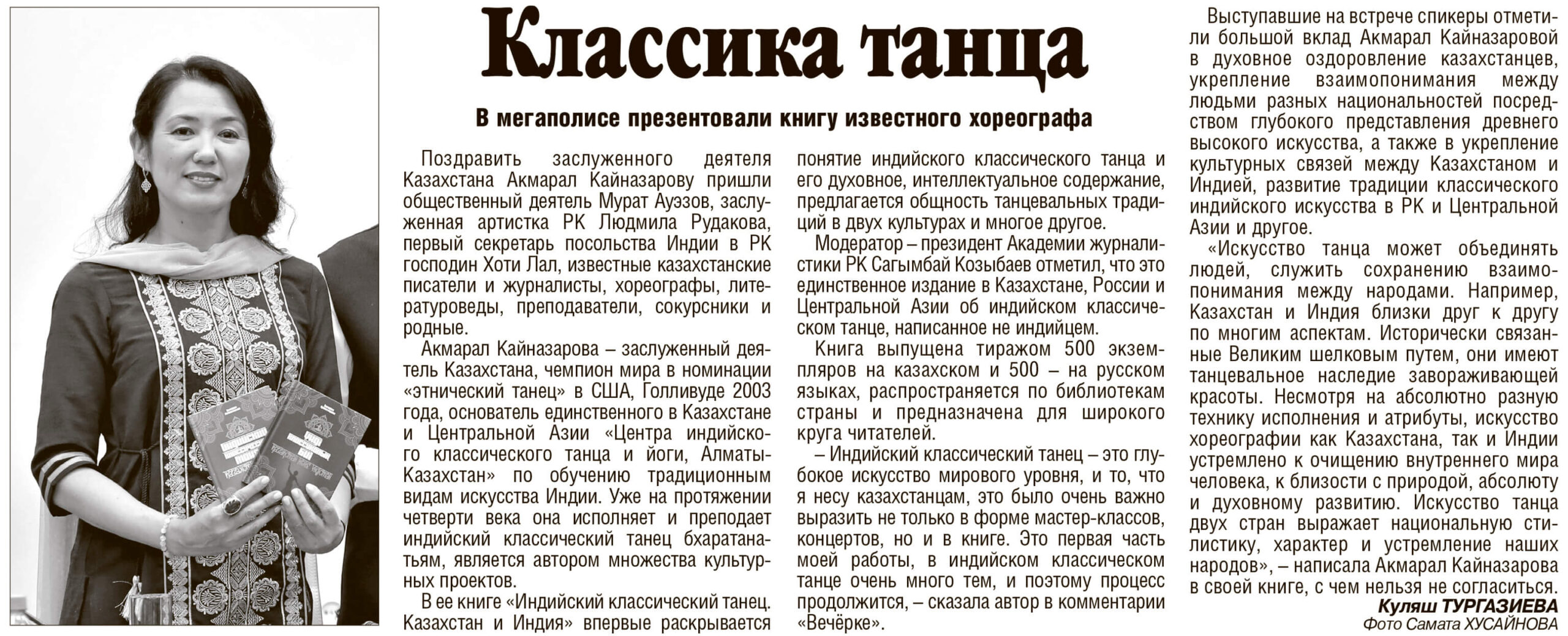
Вечерний Алматы
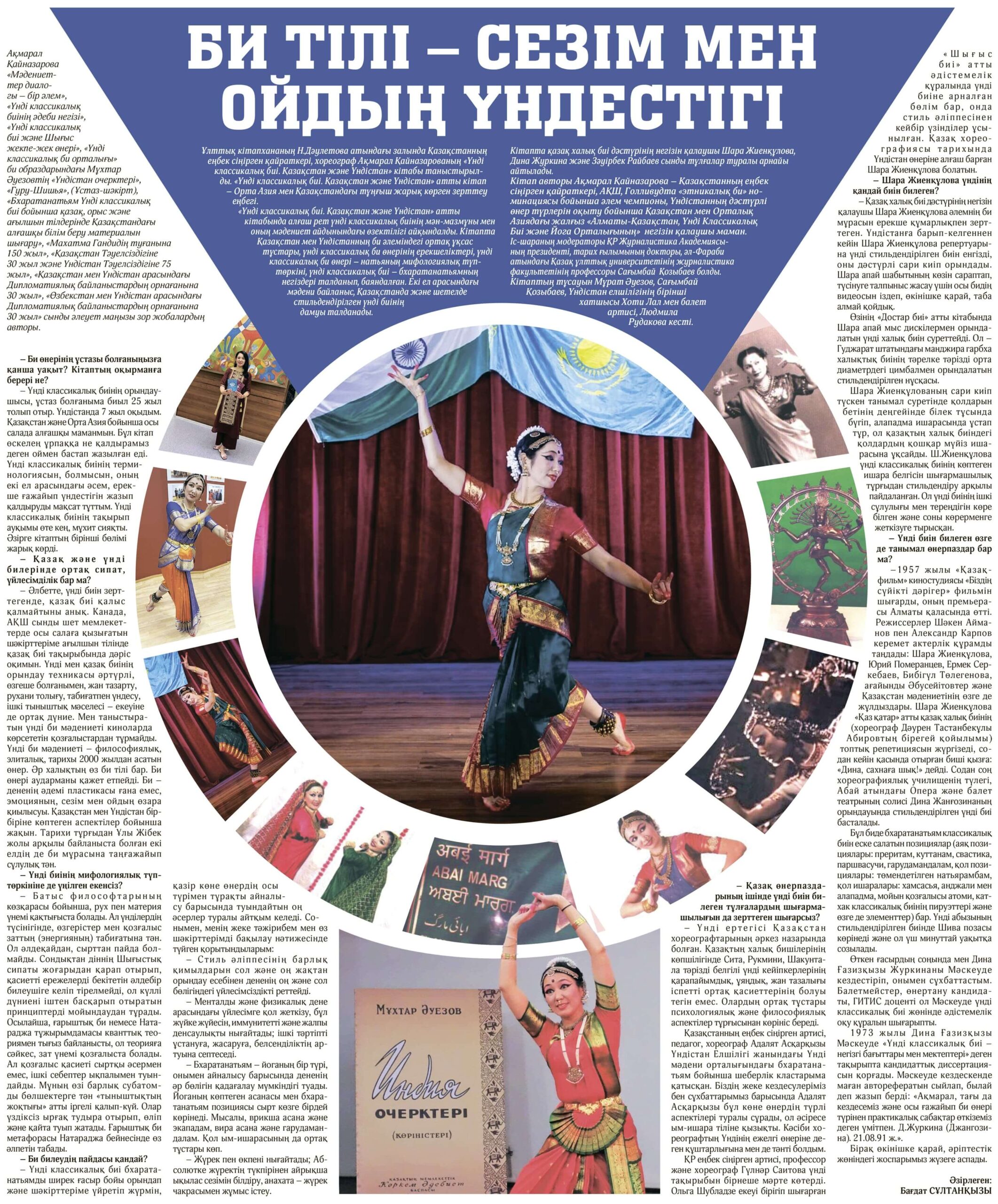
Ana Tili
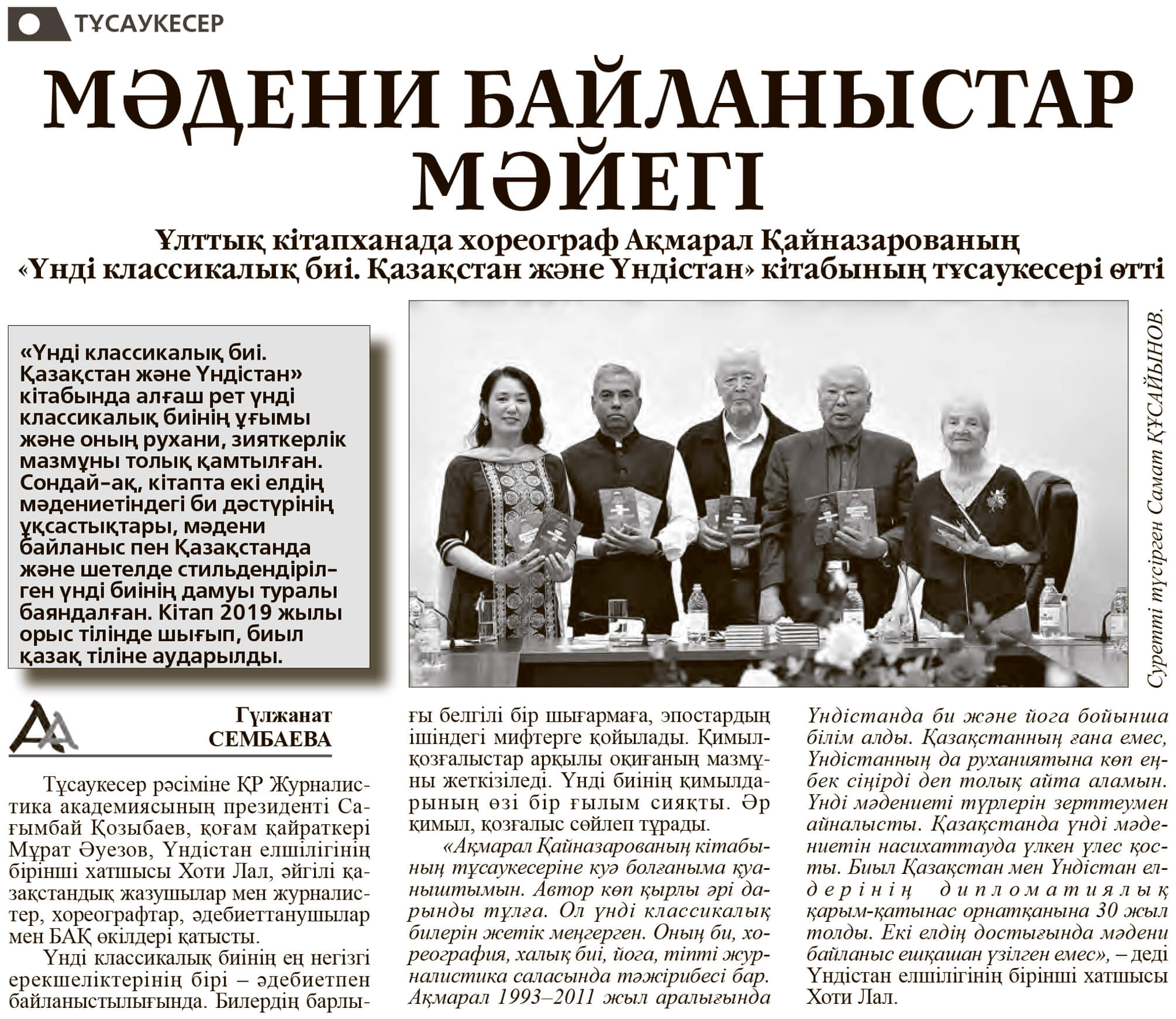
Almaty Aqshamy
«Очерки об Индии»
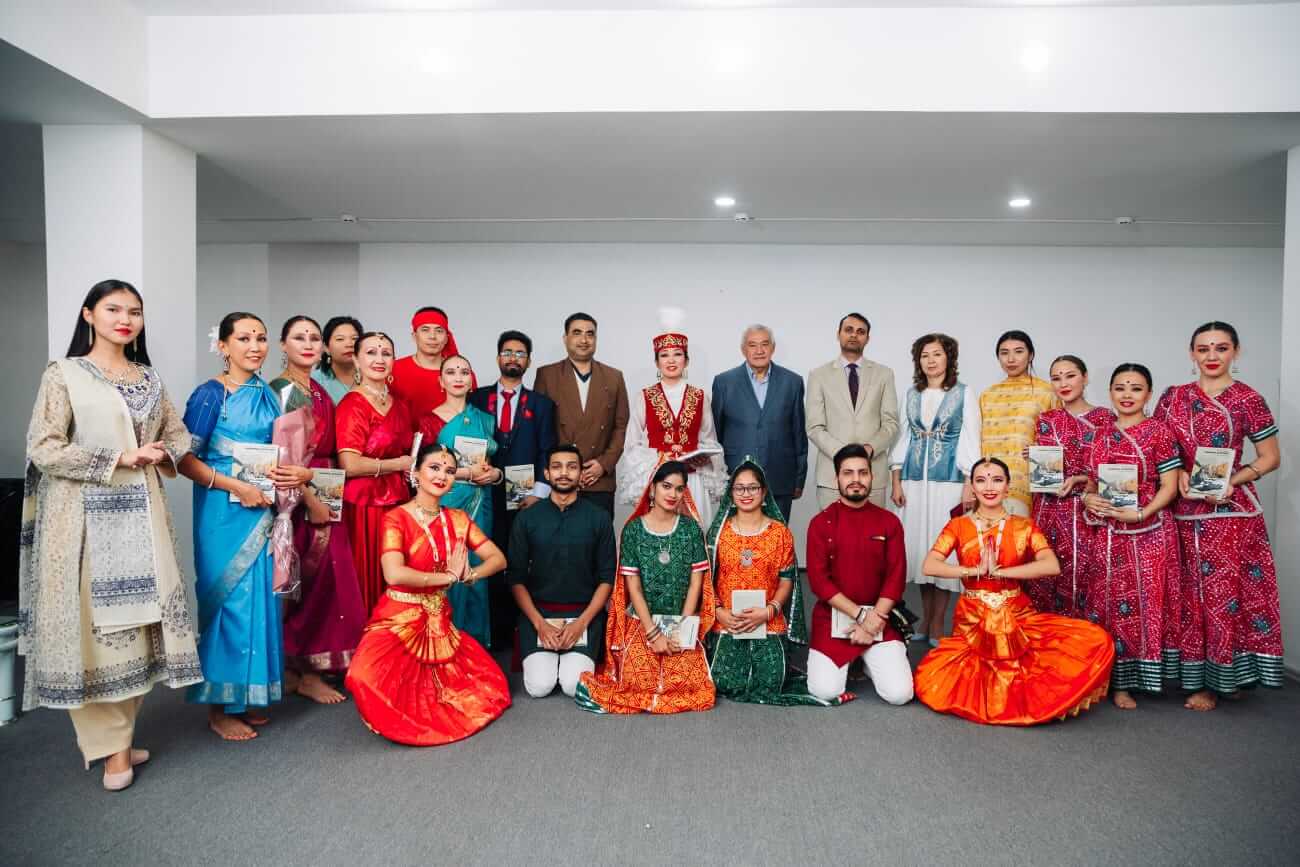
30 сентября 2022 года Научно-культурный центр «Дом Ауэзова» и «Центр индийского классического танца и йоги, Алматы-Казахстан» провели программу «Очерки об Индии» Мухтара Ауэзова в танцевальных образах в честь 125-ти летия со дня рождения великого писателя Мухтара Омархановича Ауэзова.
Выдающегося казахского писателя, крупного ученого-академика и общественного деятеля Мухтара Ауэзова знают и любят во всем мире. Мухтар Омарханович одним из первых казахских писателей посетил Индию в 1955 году. В 1958 году им были выпущены «Очерки об Индии» на казахском языке, путевые впечатления, которые современны и сегодня, интересны для всех, кого привлекает загадочная Индия. «Очерки об Индии» пронизаны глубоким пониманием культуры древней Индии, психологии простых индийцев, гуманизмом и оптимизмом.
Эти путевые впечатления, написанные Мухтаром Омархановичем в 1955 году, вдохновили на создание поистине уникальной программы, которая включает в себя отрывки из этой книги голосом Мурата Мухтаровича Ауэзова с представлением танцевального наследия каждого описанного писателем региона.
Торжественное открытие программы «Очерки об Индии» с вступительной речью начали директор Научно-культурного центра "Дом Ауэзова" Кунаев Д.А., кандидат филологических наук и консул посольства Индии в РК Амит Кумар Мишра.
Концертную программу «Очерки об Индии» Мухтара Ауэзова представил «Центр индийского классического танца и йоги, Алматы-Казахстан» под руководством Заслуженного деятеля Казахстана, Магистра искусств Акмарал Кайназаровой. Центр вносит неоценимый вклад в укрепление казахстанско-индийских связей и развитие духовности в Казахстане. Это уникальное учреждение, единственное в Казахстане и во всей Центральной Азии, является обладателем Гран При межднародных конкурсов в Европе.
Благодаря классическим и народным индийским танцам Бхаратанатьям, Катхак в исполнении «Центра индийского классического танца и йоги, Алматы-Казахстан» программа представила литературные впечатления через язык пластики тела.
В конце вечера директор мемориального дома-музея М. Ауэзова Кунаев Д.А. подарил всем участникам программы книгу «Впечатления об Америке».
Гостям программы экскурсоводом Мукатаевой С.А. была проведена экскурсия по дому-музею на английском языке. Ознакомившись с экспозицией гости заверили в творческих связях в будущем. В мероприятии участвовали гости из Индии, ученые, студенты ВУЗов, СМИ.
auezovinstitute.kz

Бiлiмдi Ел
Международную интеллектуальную программу «Гармония пяти элементов» запустили в Алматы
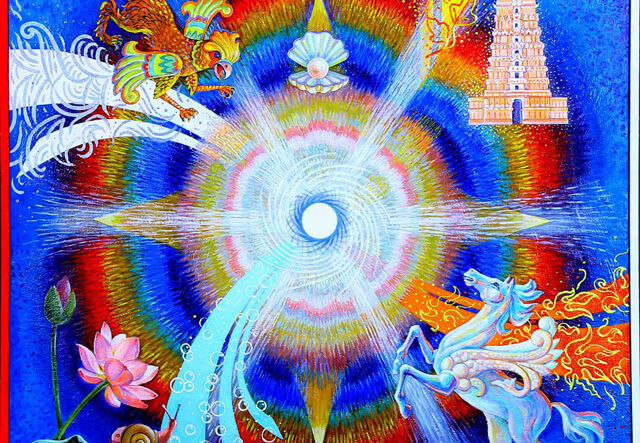
В южной столице состоялась презентация международного проекта «Панча Маха Бхута». Через классический индийский танец, живопись и йогу зрители узнали, как важна гармония человека, природы и экологии.
Панча Маха Бхута - философское течение Древней Индии об общих законах Вселенной и ходе процессов мироздания. Баланс пяти элементов - земли, воды, огня, воздуха, эфира - способствует полному оздоровлению, укрепляет иммунитет, а также влияет на внутреннюю гармонию в человеке и его отношения в социуме.
«Здоровая гармония пяти элементов в природе создает здоровую экологию, энергетику. Отсюда и гармоничные отношения между людьми. Это древняя индийская концепция. Для Индии она обыденна. К сожалению, у нас люди нечасто задумываются об этом. Отсюда дисгармония как в организме человека, так и в природе, и обществе. Концепция программы «Панча Маха Бхута» долгие годы крутилась у меня в голове. Мне хотелось, чтобы эта тема заставила людей намного глубже задуматься о своем здоровье, экологии. Поэтому появилась идея проекта, которую мы решили показать в самых разных визуальных видах искусства», - рассказала заслуженный деятель Казахстана, основатель и хореограф Центра индийского классического танца и йоги Акмарал Кайназарова.
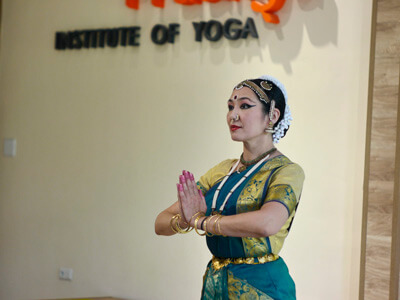
На презентации присутствовали более 90 человек. Среди гостей были генеральный консул Республики Узбекистан Аброр Фатхуллаев и глава представительства посольства Индии в Алматы Амит Кумар Мишра. Программа была очень насыщенной и интересной. Зрители окунулись в философию классических индийских танцев, йога-терапию от мастера Сиддхартха Кумар Шарма и живопись художника из Узбекистана Анны Донец.
«Мы готовили этот проект три года. Для меня важно было посредством индийских классических танцев воспеть каждую стихию, через йогу показать мантры и мудры, которые помогают привести в гармонию в организме тот или иной элемент, а через живопись – красоту пяти элементов. Мне повезло познакомится с Анной Донец, которая приняла приглашение поучаствовать в программе, хотя до этого она не рисовала индийскую тему. Ее картины получились глубокими и познавательными», - говорит Акмарал.
Картины Анны Донец вызвали интерес у зрителей. Многие подолгу задерживались возле них, погружаясь в философию живописи.
«Когда Акмарал рассказала мне об идее проекта, я сразу заинтересовалась. Я занимаюсь йогой, немного увлекалась танцем Катхак, поэтому тема пяти элементов меня увлекла. Каждая стихия - это отдельный мир. Много времени было посвящено сбору информации, прорисовке эскизов. Мне самой ближе и интереснее эфир как центр всех великих стихий, соединитель и источник энергий. Картины написаны масляными красками, акрилом, контурами. Каждому элементу соответствует определенный цвет. Участие в проекте меня очень вдохновило», - отметила художник Анна Донец.

По словам организаторов, в планах развивать программу и показать ее в Узбекистане, Таджикистане, Туркмении, Азербайджане. Надежда Пляскина, фото предоставлены участниками проекта «Панча Маха Бхута», Алматы
Elitar.kz
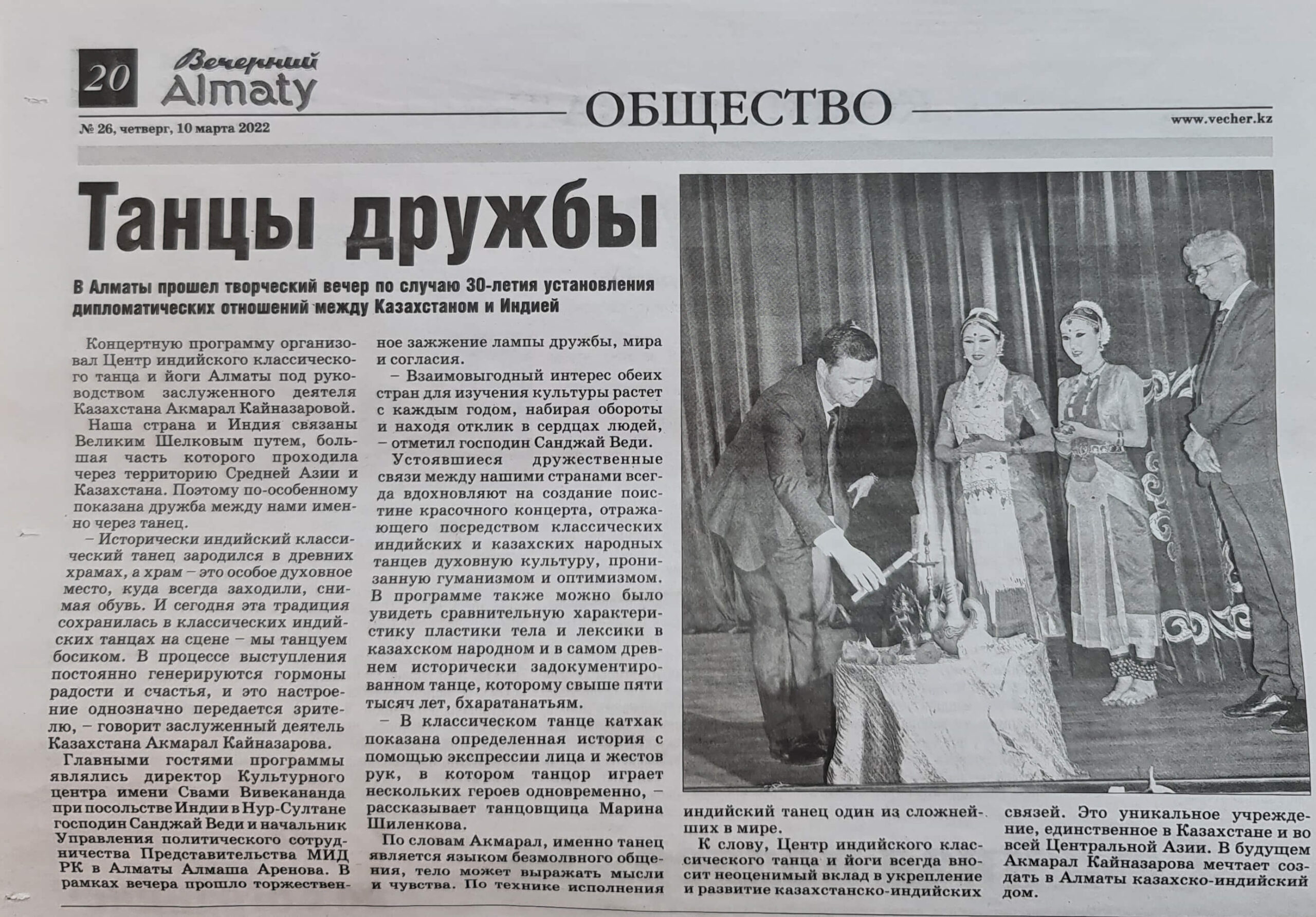
"Вечерний Almaty"
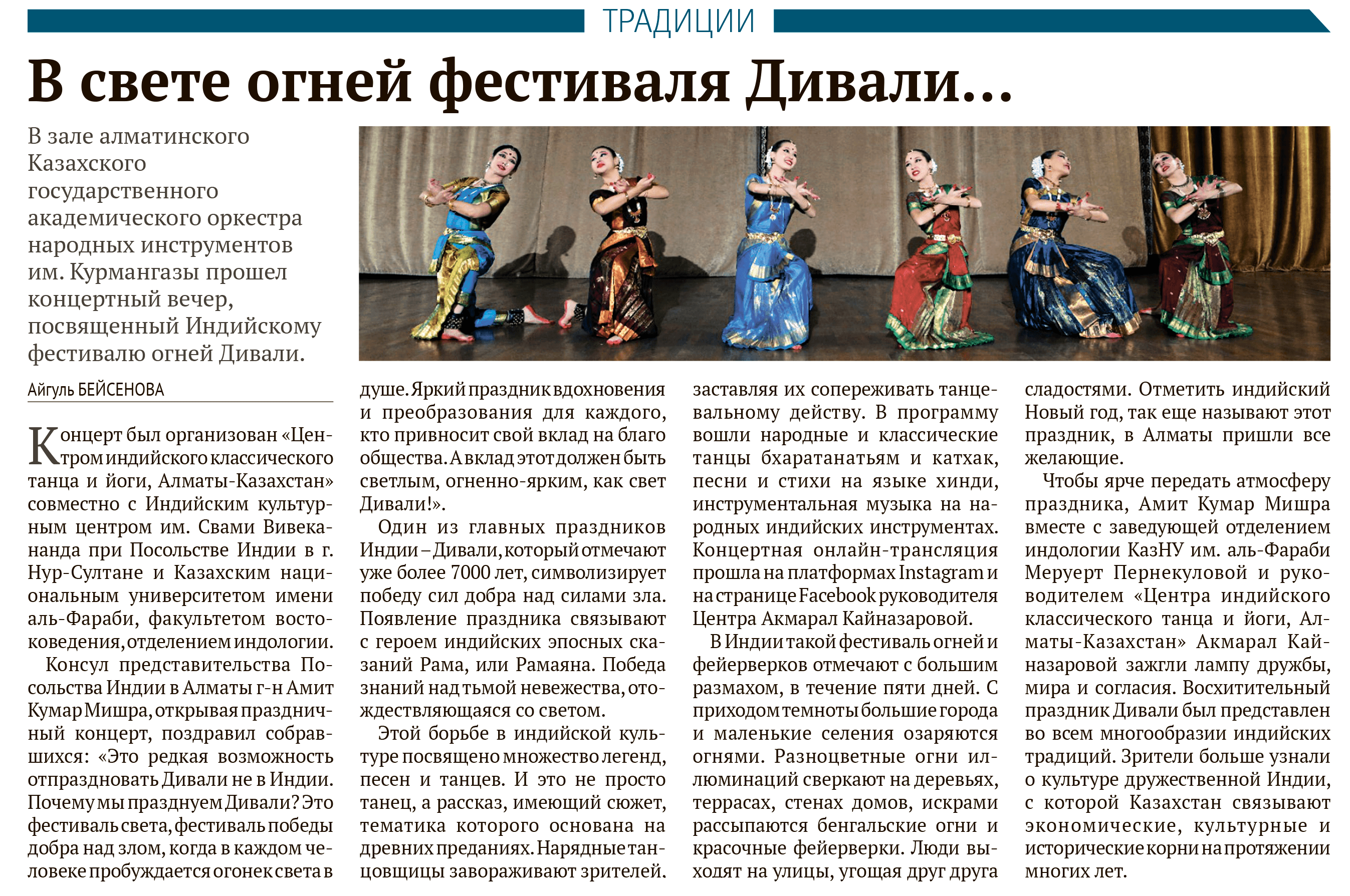
"Деловой Казахстан"
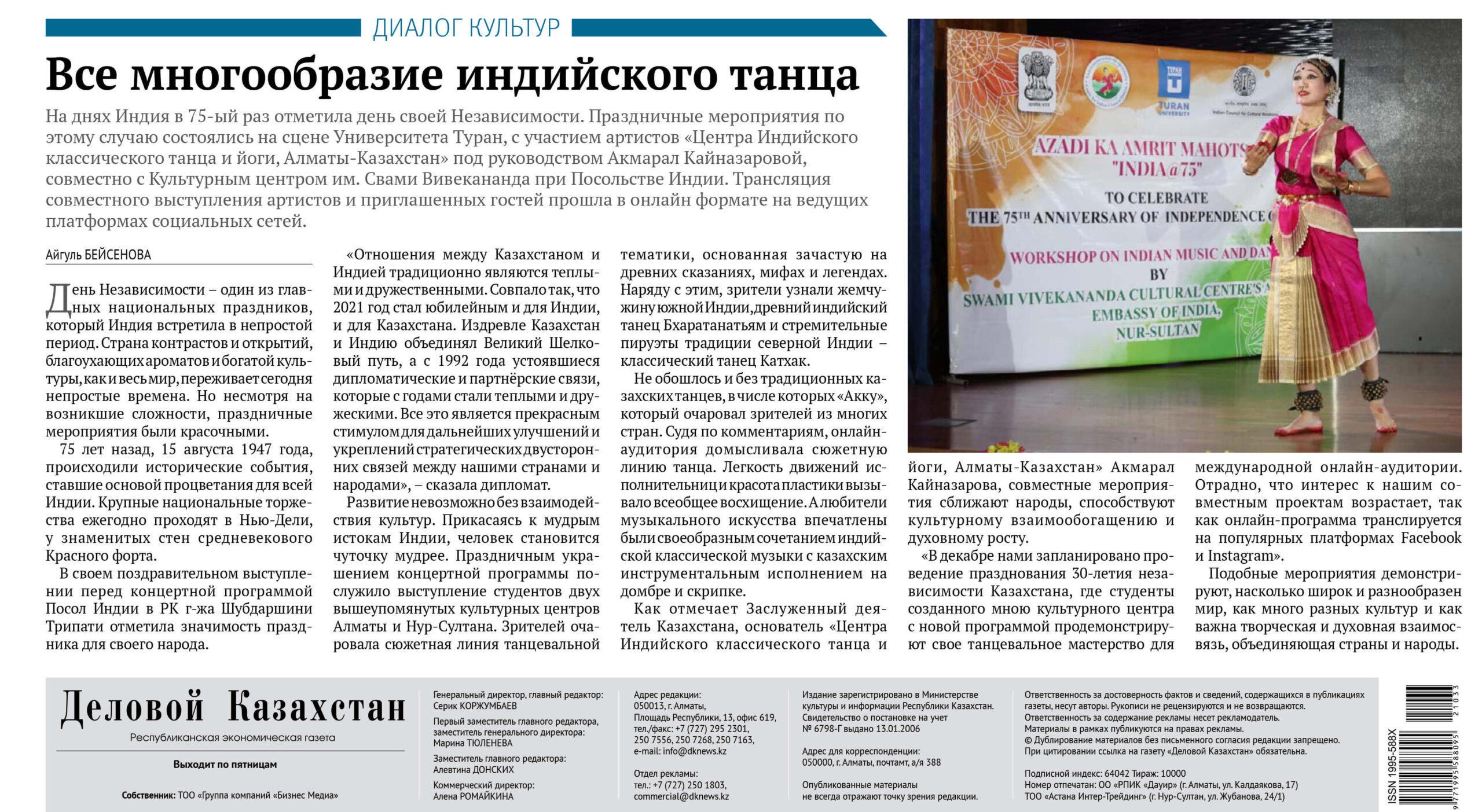
"Деловой Казахстан"
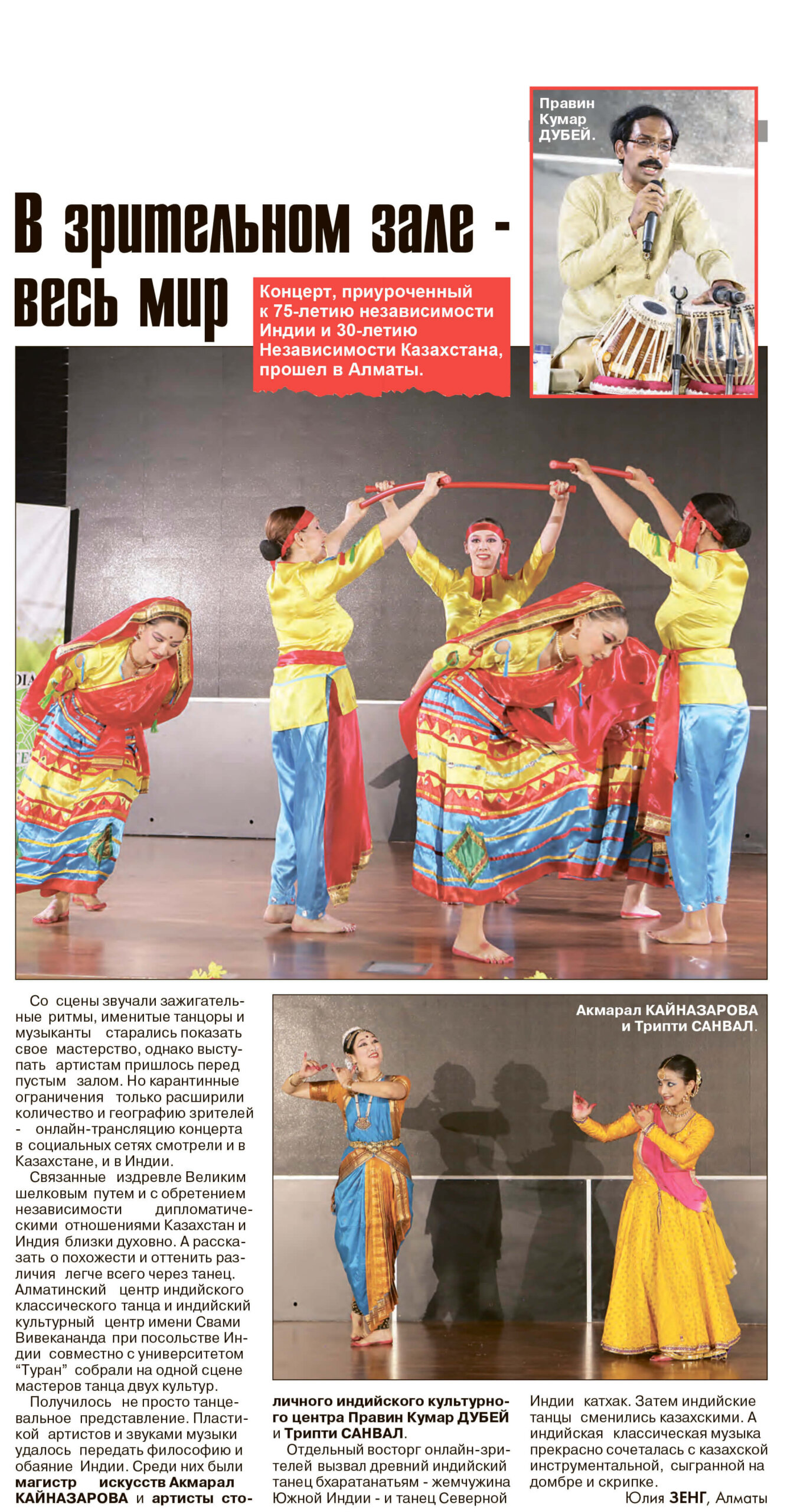
"Время"
Акмарал Кайназарова: Искусство танца божественно и прекрасно
Танцевальная культура разных народов сплелась в едином онлайн-выступлении, посвященном Международному дню танца и Дню единства народа Казахстана.
Организатором выступил «Центр Индийского Классического Танца и Йоги Алматы-Казахстан» под руководством заслуженного деятеля Казахстана Акмарал Кайназаровой совместно с Культурным центром им. Свами Вивекананда при Посольстве Индии в Казахстане.
Центр Индийского классического танца единственный в Казахстане и Центральной Азии. Здесь возрождаются традиции древнего танца Бхаратанатьям, соединяя философию Индии с древней и самобытной духовностью тюркских народов Великой степи.
– Международный день танца среди других проектов является важным событием для нашего центра. Этот праздник вдохновил на проведение поистине красочного концерта, отражающего посредством классических и народных танцев духовную культуру древней Индии, Казахстана и стран Центральной Азии. Отрадно, что индийский танец как уникальное явление в танцевальном мировом искусстве нашел свое достойное место в широком спектре искусств, представленных сегодня в Казахстане, – говорит Акмарал Кайназарова.

Программу концерта составили индийские классические танцы Бхаратанатьям, Катхак, казахские, узбекские танцы. Онлайн-программу на платформах Facebook и Instagram на сегодняшний день посмотрели более 500 зрителей из разных стран мира, оставив добрые и вдохновляющие отзывы.
– Такие программы во время пандемии очень актуальны. Ведь они поднимают настроение людей, мотивируют танцевать и вести активный образ жизни, вдохновляют оптимизмом и гуманизмом. Искусство танца божественно и прекрасно! Ведь не зря казахское слово «би» переводится как верховный, главенствующий! – делится Акмарал.
"Вечерний алматы"
В ритме древнего танца

Онлайн-концерт из Казахстана за один вечер посмотрели свыше 500 зрителей из разных стран. Поклонники искусства танца оказались щедрыми на похвалу, восклицая на разных языках: «Элегантно!», «Концерт доставил огромное удовольствие!», «Красиво!», «Зажигательно!», «Браво!», «Казахский танец удивляет и увлекает».
Праздничный концерт, в который вошли казахские, узбекские, индийские танцы, подготовил Центр индийского классического танца и йоги под руководством заслуженного деятеля РК Акмарал Кайназаровой совместно с культурным центром им. Свами Вивекананда Посольства Индии в Казахстане.
Казахский танец как подлинное явление народного искусства продемонстрировал самобытность и глубину чувств. По словам Акмарал Кайназаровой, в честь весны в программу они включили казахский танец «Наурыздағы жүздесу». В завершение композиции, наполненной символами многовековых традиций народа, танцовщица угощала шубатом и поздравляла с Наурызом.
Узбекский танец из Хорезма отличался своей зажигательной природой. Зрители подметили все тонкости: удивительную гибкость пальцев, запястий и плеч у исполнительницы, что как раз присуще древним танцевальным традициям Узбекистана. При этом скорость исполнения танцовщица увеличивала с каждой минутой, заряжая весельем и позитивной энергией.
Программу украсили также индийские классические танцы бхаратанатьям и катхак. Девушки показали, что этим древним танцам присуща не только точно выверенная геометрия движений, но и их сочетание с театральной экспрессией и символизмом. Это действительно красивые танцы, завораживающая магия которых оттачивалась веками. Танцовщицы использовали возможности взгляда, движений бровями, кистями рук, чтобы продемонстрировать глубинную суть искусства Индии.
Международный день танца призван объединять людей и помогать общаться на одном языке танца. Важная роль в популяризации этого искусства принадлежит Международному совету танца (CID) при ЮНЕСКО. Акмарал Кайназарова в 2004 году стала первым хореографом из Казахстана – членом CID. Она прилагает много усилий, чтобы со своим коллективом готовить каждый год праздничные концерты и таким образом популяризировать искусство танца.
– Праздники онлайн актуальны во время пандемии, – считают участницы концерта. – Танцы вдохновляют и мотивируют быть активными, помогают поддерживать здоровье. А еще они дарят прекрасное настроение и радость жизни.
Казправда
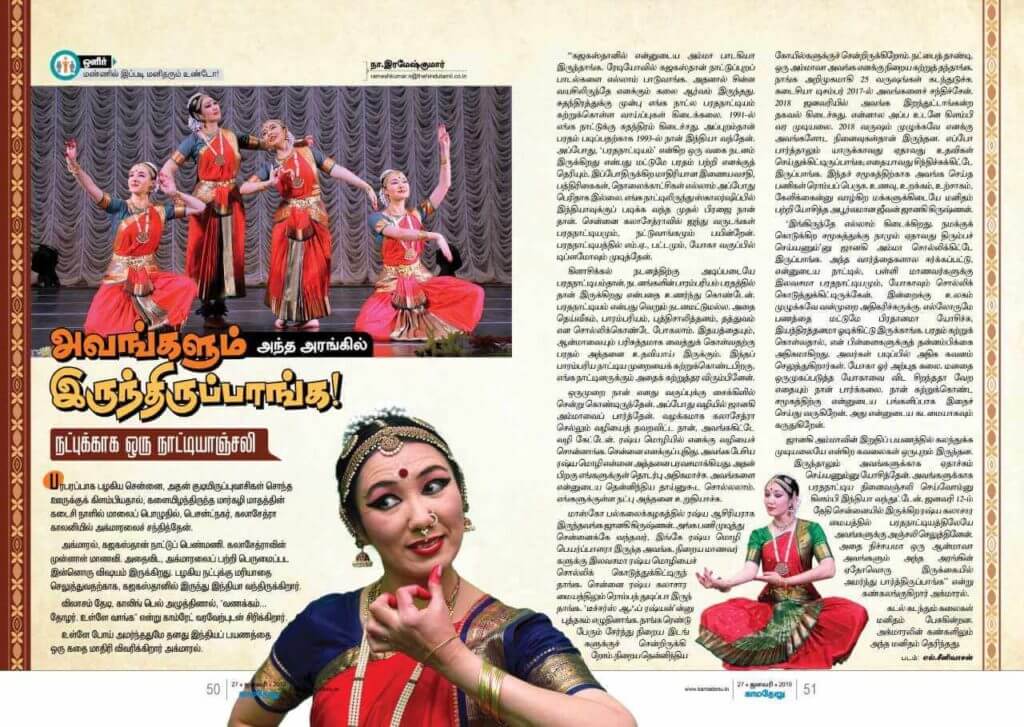
TRANSLATION OF TAMIL ARTICLE PUBLISHED IN A MAGAZINE CALLED KAMADHENU. WRITTEN BY MR RAMESH KUMAR. PUBLISHED ON 27TH JAN 2019.
Title of Article: Natyanjali for Friendship (written inside brown box).
“She (Janaki Krishnan) would have been there in the auditorium” written in yellow.
The city of Chennai had lost its bustle after a hectic music season in the month of Margazhi [Dec 16 to Jan 13]. I met her on the last day of Margzhi at Kalakshetra Colony.
Akmaral is a citizen of Kazakhstan, a former student of Kalakshetra. There is an yet another aspect to feel proud about. To pay a tribute to friendship, she had arrived in India from Kazakhstan.
When I found the address and pressed the calling bell, she welcomed me with a smile saying «Vanakkam, please come».
Once I sat down, she proceeded to describe her Indian visit as if it is a story.
«In Kazakhstan my mother was a singer and she used to sing folk tunes. So from a very young age I developed an interest in fine arts.Before Independence of our country, there was no opportunity to learn Bharathanatyam. In 1991, our country became independent. After that, in 1993, I came to India to study Bharathanatyam. At that time all I knew was it was a form of dance. In those days internet, newspapers, TV channels etc were not that common. I am the first citizen of my country who came to India on a scholarship of Indian Government for study. At Kalakshetra, Chennai I studied for five years Bharathanatyam and nattuvangam. I obtained MA DEGREE in Bharathanatyam and a diploma in Yoga.»
Bharathanatyam is the foundation of classical dance. I realized that traditional dance has its roots in this dance format. It is not just a dance format: you can add many aspects like divinity, tradition, intelligence, philosophy etc. After learning this traditional dance, I wished to teach this to people of my country.
One day I was going on bicycle to my class. On way I met Janakiamma. I had missed the path to Kalakshetra and asked her the way. She replied to my question in Russian. I was very excited. We then became very close to each other. One can say she is my South Indian mother.
Janaki Krishnan was a teacher of Russian language in Moscow University. After serving there, she returned to Chennai. She was a translator here and she taught Russian language for free to many students. She was an active member of Russian Cultural Center. She wrote a book called TEACHERS OF RUSSIAN. She and I had visited many places and many temples. She was more than a friend; she was a mother who taught me many things. It is 25 years since I met her and the last occasion I saw her was in December 2017. I got the news she had passed away in Jan 2018. I could not travel at once. Throughout the year 2018 I was full of her memories. She was always helpful to people, doing things and also thinking further. She had done immense service to society. In a world where people think of food, sleep, enthusiasm and entertainment, she was one soul that cared for humanity.
«We should return to society what we have got» were the words she often said. Attracted by those words, in my country,I teach students Bharathanatyam and yoga, for free. Today there is a lot of violence in the world. People regard money as the most important thing. Life is very mechanical. By learning Bharathanatyam my students have more self confidence and they are better at studies. Yoga is a great science and is a tool to discipline the mind.I do this as a service to society and I consider it as my moral obligation.
Although I was unhappy I could not take part in the final journey of Janaki amma, I wanted to do something in her memory and so I came to India. I presented a Bharathanatyam recital at Russian Cultural Center on 12th Jan 2019, in her memory. She would have witnessed that by being present in the audience, said Akmaral with tears in eyes.
Crossing oceans, art brings humanism. Akmaral’s eyes show that humanism.
———————
This is a sentence-for-sentence translation. Almost accurate. The original meaning in Tamil has been conveyed in English almost entirely say 95%. I have not altered the English text to make it look polished for an English reader. Each paragraph in English represents each paragraph of Tamil report. There are eleven paragraphs.
—-
A Tamil Magazine reporter met Akmaral and had an interview. That article has been published. Akmaral requested for translation. The journalist has done a good job. The article is very nice when read in Tamil.
Translation of the article in Marathi language, which was published in Mumbai newspaper LOKMAT on 31st May, 2020.
Author is the senior publisher and journalist Mrs Vandana Atre.
Travel of my life dreams
I wanted to look beautiful, like the female protagonists of Tagore’s stories. I grew up listening to his stories, thousands of miles away in the Central Asian nation, in Kazakhstan. I and my grandmother Karima loved being part of Tagore’s stories and reading them. The luxuriant hair and beautiful eyes of the women in his stories, the lush green fields of West Bengal, its perennial rivers and the happy families living besides them and their stories, all of that was an entrancing vision of India which I had never really seen in my life around me. But as I was growing up, all I could see was what I thought was my frail body and not very happy and radiant face.
My mother Sazhida sang the local Kazakh songs really well. In her high, sharp voice, she captured the beauty of the music extremely well. She was famous, a point of discussion among the people around us, and I was proud of my Mom. Besides her, I always thought I was nothing, a nobody, very shy and timid … In my adolescence, I had only one passion, to learn to dance and become fit and beautiful through dance art. While there was always the option of sports for gaining health, but I wanted to learn to dance. I then started reading about India and I thought I would be able to learn through my reading.
At that time, Russia had a strong hold on our country since we were technically a republic within the Soviet Union. Traditional Kazakh Music and dance was frowned upon in those times. But I found a dance I liked, Bharatanatyam! Rhythmic movements, body language, balance, an aesthetic costume, and a strict discipline in its steps and performance. I was looking exactly for something like this. Connection with inner world, nature, reflection of relations between human being — all can be found in beautiful Bharatanatyam dance.
My aim was to learn reach Bharatanatyam art. I then started exploring some opportunities in the Indian Consulate in Uzbekistan, and I tried to persuade them to let me to go to India to learn dance. As expected, I did not get a single response. I then tried another my own way to learn dance. I gathered as many images I could find of Indian dance postures from books and magazines and tried to create a blend of Indian dances. I started teaching this to some local people. I was studying for my Master’s in journalism due to my father’s insistence.
While working in the army, having fought in World War II and served at many high positions in the Army and police forces, my father Yeleusin had written many books. He was insistent I do the same, learn, get married and then work somewhere and then possibly if it left any space in my life, to learn and practice dance. Just then, Kazakhstan became free of the Soviet Union, got Independence. This gave me the freedom to explore Indian dance much more freely, to fulfil my dreams.
I then went back to the Indian Embassy as soon as it open and showed dance performance with my students. They were impressed, and finally agreed to help me get to India. I was the first Kazakh student to come to Kalakshetra after getting an ICCR scholarship. I was stunned to see the crowd of people at Chennai airport. This was an antithesis to the sparsely populated Kazakhstan. Somehow, I also realized that they were speaking some form of Kazakh. Later, after starting to learn Tamil, I realized that the grammar of Kazakh and Tamil was quite similar.
I started learning, and I did not want to waste any time since I was already late to start learning. For five years after that, I was only studying dance, I practiced dance in the morning, afternoon and later at night, studying Tamil and Sanskrit. I did not do anything like going here and there, enjoying with friends or anything similar to the other youngsters of my age. This was especially tough for me since Indian dance needs a linguistic context and an understanding of the words, without which the emotions in it are not understood properly. The epics of Ramayana and Mahabharata, the stories of Shiva and Parvati, the stories of Kalidasa and the Ashtapadis of Jayadeva, all needed a depth of understanding and interpretation. Naturally, it was going to be tough to understand a two millennium old tradition in five years. After staying in India for five years, I left in 1998. But then came back again and again to learn more and more on Bharatanatyam. Much later I started coming to learn Kathak to Delhi so that I would be able to teach more types of classical dance to the people of my country. In 2011 I completed my Master’s in Bharatanatyam and a PG diploma in Yoga Therapy. I also learnt Carnatic music at that time. I was simply striving to become a good artists, you have to do many efforts, and efforts are always not enough and very necessary. Then only you can inspire many people as well.
While staying in India I always felt as if I was a monk in my last birth, roaming the vast plains of India as an ascetic.
Now, at the Centre for Indian Classical Dances in Almaty, the students learn dance but also the thoughts and philosophy behind each and every dance item. Indian dance is always beyond entertainment and visual or aural pleasure. Indian dance provides a new perspective of humanity to you. The Shlokas and stories in Bharatanatyam always show a human rising above wickedness towards goodness and ultimately, divinity. This dance form combines for example ancient stories of Ganapati but also addresses pressing contemporary problems. The fraying relationships between people, the greed of mankind, and the rising loneliness of man in an increasingly interconnected world. And How to create the beautiful society – that is my effort to show people through my dance art.
I had always felt a similarity between Kazakh and Indian social life. Family values was a common point of emphasis in these cultures. I am now also trying to create a blend of Kazakh and Indian dance as a tool to show people closeness of our countries and cultures.
I am trying to do my bit in ensuring that dance never loses its relevance as we march ahead. Values of Classical dance will never vanished. To make this values to realise to young generation I am also currently working on book on the Mudras in Bharatanatyam and their impact on our health. Just as my Centre in Kazakhstan is the first in the country, I am striving that my book will be such a trendsetter too.
I somehow feel that nature and its elements were trying to tell me something. I somehow had anticipated a crisis like the ongoing COVID crisis. Currently, I and my friend Anna Donets, an Uzbek painter, are working together to create a joint performance on the five elements, combining her painting and my dance. We are trying to attract people’s attention to hidden energy of Mother-earth. We are trying to bring the world back to the message of preserving nature and in learning from this unprecedented crisis that has befallen on the world. I have always aim in my life.
Vandana Atre
Introduction
Akmaral Kainazarova is Central Asia’s first Guru of Indian Classical Dance. She has been a disciple of both Bharatanatyam and Kathak and has also completed her postgraduation in Yoga. She is taking Indian culture and spiritual foundation to Kazakhstan. She is currently authoring a book on the Mudras of Bharatanatyam and their significance on our physical and spiritual well-being.

